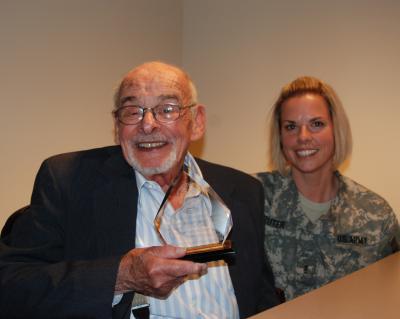Holocaust survivor and World War II veteran speaks to New York National Guard Soldiers and Airmen
| DMNA Home page | More News Stories |
Story by: Eric Durr - Division of Military and Naval Affairs
Dated: Wed, Apr 30, 2014
LATHAM, N.Y. - Martin “Marty” Becker was German once. But that was in 1940, before he and his parents and other lucky German Jews fled Hitler’s Germany. By 1945, Marty Becker had graduated high school in Albany, N.Y., been drafted into the U.S. Army and fought against Japan, and returned home as an American citizen and survivor of the holocaust which claimed the lives of 6 million Jews, including his sisters and brothers-in-law.
On Wednesday, April 30, Becker brought his family story of Holocaust survival and death to New York National Guard headquarters.
He spoke to 100 civilian employees and military members during a lunchtime program here sponsored by the New York National Guard’s Equal Opportunity Office to recognize Holocaust Remembrance Day, which was April 27.
For the last 20 years, his passion has been educating people about the Holocaust, Becker said. As an active member of Jewish War Veterans he jumped at the chance to talk to Guard members about the Holocaust when he was asked, he explained.
Becker centered his talk around a book published in 2012 called “Descent into the Abyss: The Shoah rdquo; a philatelic retelling."
The book, by New Zealander Bruce Chadderton uses postcards and stamps to tell the story of the Nazi takeover of Germany, the anti-Jewish laws that were passed, and the eventual murder of millions of German and European Jews in death camps.
A 1941 postcard from Becker’s brother-in-law, Herbert Sohn to his family, is one of the postcards used to tell that story in the book. Photos of young Martin Becker, and his mother and his father, are also featured in the book.
The Sohn’s and their daughter died in a death camp while Martin Becker was growing up as an American teenager following a yearlong effort to escape Germany and get to the United States. His father had thought that Hitler and the Nazis were a political fad that would not last, Becker told his audience. But after the Kristallnacht of Nov. 9, 1938, when so many Jewish businesses were trashed that the broken window glass made the streets glitter like they were made of crystal, the elder Becker changed his mind.
Martin Becker’s father was arrested by German police and when he returned home three days later, his teeth were gone and so was the World War I veteran and patriots attachment to his native country, Becker said.
His parents sent 12-year-old Martin to France to live with a relative there while they waited for permission to immigrate to the United States. When World War II broke out, Martin was classified as a stateless enemy alien, which meant he had to wait in France while his parents left for the United States.
In the spring of 1940, just before Germany and Italy invaded France he left Europe on the last Italian ship heading for America. He tells these stories today, Becker told the Soldiers and Airmen, because as World War II gets further and further away in time it becomes easier to forget the horrible things that people did to each other.
“If we do not remember it, it will happen again,” Becker said.
He also got a laugh from his military audience when he briefly related his military experiences in the U.S. Army Air Forces.
He was drafted when he turned 18, Becker said, and was originally slated to go to Germany as a Soldier in an Allied Military Government unit since he was a native German speaker.
But instead, the Army turned around and sent him to “Fort Rucker, which was worse than Germany” and then to Fort Dix, where the Army decided it made more sense to send a German-American Soldiers to the Pacific.
Some things, he said, don’t ever really change.
URL: https://dmna.ny.gov/news/?id=1398887683
216.73.216.182
Page Last Modified: Wed, Apr 30, 2014




